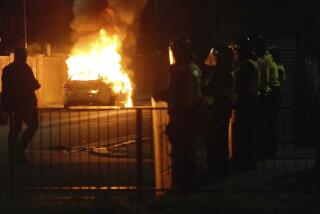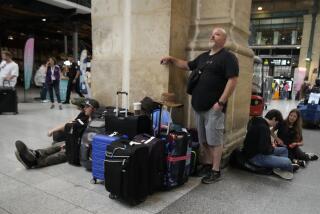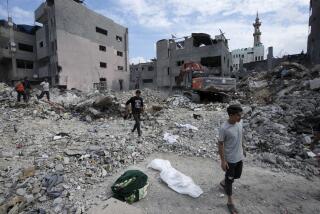Subway Bombs Were Tightly Synchronized
- Share via
LONDON — As distraught families protested the slow recovery and identification of bodies from Thursday’s attacks, police revealed Saturday that the bombs used in the three doomed subway trains had been detonated within seconds of one another -- a far more chilling level of synchronization than originally believed.
And in a sign that this remains a country on edge, Britain’s second-largest city was thrown into panic by a security alert Saturday night. Police responding to a report of a suspicious package on a bus evacuated 20,000 people from the center of Birmingham, a teeming industrial city two hours north of London. No bomb was found.
In London, authorities said badly mutilated bodies of bomb victims might not be identified for days. The death toll stood at 49 but is expected to rise significantly. Many bodies remain trapped in a tunnel 100 feet below ground.
Scotland Yard said Saturday that no suspects had been arrested, raising fears that the culprits might carry out additional attacks. After last year’s Madrid train bombings, several key suspects had already been taken into custody by this point.
Scotland Yard also announced that examination of electronic evidence confirmed that three of the four rush-hour bombs had exploded within 50 seconds of one another, not the half-hour previously reported, suggesting a higher degree of coordination.
The revelation bolstered the theory that timers had been used to detonate the explosives, an important clue in establishing the method and identity of the bombers. It suggests that the assailants set the bombs to go off at the same time and would have been able to deposit the devices, believed to be concealed in backpacks, in the trains before escaping.
“It was bang, bang, bang -- very close together,” Tim O’Toole, managing director of the London Underground, said of the near-simultaneous blasts.
The use of simultaneous bombs also means there would be no time for authorities to alert travelers and save lives.
Police previously said that each bomb weighed less than 10 pounds and was left on the floor near the door of the subway cars, on the Piccadilly and Circle lines. On Saturday, they added that the bombs were composed of “high explosives,” meaning something such as TNT or plastics, not a homemade brew of chemicals.
Deputy Assistant Police Commissioner Brian Paddick declined to identify the material further and cautioned against reaching conclusions at this early stage.
The fourth bomb, which detonated on a double-decker bus 57 minutes after the first blasts, remains a mystery. Possibly it was meant as a second attack timed to hit people fleeing the first wave of attacks, or perhaps the bomber failed to reach the intended destination and the device exploded prematurely.
British investigators told their European counterparts, arriving in London on Saturday to assist in the probe, that they favored the latter theory.
“It could be something as simple as that the bomber intended to hit a subway, but was scared off when he saw a policeman or something. Then he ended up on the bus, which was diverted after the first three explosions,” said a European law enforcement official who was briefed by British authorities.
The evidence so far suggests a fairly simple type of bomb, but detailed planning and execution by people who had knowledge of London’s transit system.
Authorities are investigating whether the terrorist attack, the deadliest on British soil, was the work of any of the several Islamist cells that have formed in London in recent years.
With Britain’s liberal asylum policies, London has evolved into a major hub for a multiethnic cross-section of Islamic extremist ideologues, recruiters and operatives.
Investigators said they had not narrowed their search to a specific nationality or ethnic network, but several European officials said they were convinced that a Moroccan-dominated group was responsible. Moroccan extremists have been active in Europe, allegedly having taken the lead role in the Madrid bombings and in the assassination in November of Dutch filmmaker Theo Van Gogh.
Several Moroccans suspected of being top planners of the Madrid attack, which killed 191 people, remain at large and were traced at one point to London.
In that vein, suspicion has focused on Mohammed Gerbouzi, who has lived in London for years despite court charges in Morocco identifying him as a leading figure in the Moroccan Islamic Combatant Group, a network implicated in the Madrid and Amsterdam cases as well as bombings in Casablanca in 2003.
Gerbouzi “is probably not involved directly with the British attacks because he felt targeted, but there may be people in his circle who have participated,” said Louis Caprioli, the former head of France’s DST anti-terrorism intelligence service.
The Times of London quoted Gerbouzi’s family as saying he was in hiding and was not involved in Thursday’s bombings.
Also connected to the Madrid case, as well as to the Sept. 11 attacks in the United States, is Syrian-born Mustafa Setmarian, an alleged Al Qaeda operative who ran training camps in Afghanistan and then purportedly set up a terrorist network in Spain. His whereabouts are unknown, and his name has been mentioned in the British press as a likely suspect.
As the search for the attackers continued, authorities began reopening parts of central Birmingham to the public today after Saturday night’s evacuation. Police had blocked roads into the city center as helicopters flew overhead. Restaurants were shut and hotels emptied; some people slept at a nearby university, wire services reported.
Meanwhile, in London, desperate families pressed for information on missing loved ones and complained about the government’s failure to provide lists of the dead and injured.
Authorities are moving at a slow pace in identifying bodies and notifying families. A Metropolitan Police official in charge of body recovery said it could be weeks before the names of the dead were released, adding that priority was being given to the collection of forensic evidence for the criminal investigation.
The official, Det. Supt. Jim Dickie, said only 13 bodies recovered from the double-decker bus had reached the medical examiner’s morgue where autopsies would be performed. Probably 20 to 25 victims remain trapped about 100 feet underground in one shattered train car between the King’s Cross and Russell Square stations.
“We hope to receive the bodies and body parts, which we hope to be able to reconcile,” Dickie said. “It is a very harrowing task. Most of the victims have suffered intensive trauma, and by that I mean there are body parts as well as torsos.”
Most of the personnel doing the recovery work performed similar tasks after December’s tsunami in southern Asia.
Many of the nearly 70 people still hospitalized lost limbs in the explosions, Dickie said.
The slow pace of recovering remains is attributable in part to the grueling operation at Russell Square, the deepest and narrowest section of subway tunnel hit in the attacks. Crews in hazmat suits must descend slowly into the cramped tunnel, where the air is heavy with dust, heat and the fumes of decomposing corpses.
Sgt. Steve Betts of the British Transport Police, writing in the Guardian, described what he saw: “The roof had collapsed and we had to almost crawl in. There were body parts everywhere, there was not one bit as far as I could see that was not covered with organs or blood or bits of body.... It was like collecting a lot of shop dummies and then cutting them up, pouring black paint over them, and filling the carriage.”
Despite the scant information from officials on the victims, a picture has emerged of the dead and injured -- native-born Britons and immigrants of many faiths, all caught on their way to jobs, school or shops.
Prime Minister Tony Blair, in a long radio interview Saturday, again praised the resilience of the British people in the face of an onslaught he said had been expected and inevitable.
“As a government, you have to do everything you can to protect your people,” he said, “but if there are people prepared to go on the Tube or a bus and blow up wholly innocent people ... you can have all the surveillance in the world and not stop it.”
Times staff writers Sebastian Rotella in New York and Janet Stobart in London contributed to this report.
More to Read
Sign up for Essential California
The most important California stories and recommendations in your inbox every morning.
You may occasionally receive promotional content from the Los Angeles Times.














